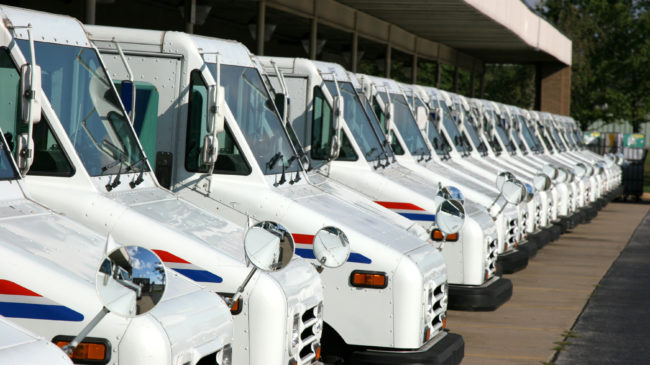Like most industries and companies, the U.S. Postal Service’s revenues are being hit hard by the coronavirus pandemic and economic downturn.
The Health and Economic Recovery Omnibus Emergency Solutions (HEROES) Act recently passed by the House would give the USPS a $25 billion bailout. But that potential influx of stimulus cash wouldn’t come with strings requiring USPS to reform itself in meaningful ways. The Senate says it won’t take up the HEROES Act, but that’s not the last we’ll hear of the Postal Service’s need for more taxpayers’ dollars.
As lawmakers consider future USPS funding and regulations, rather than bolster the status quo, Congress should seek to encourage the Postal Service to evolve in ways that would make it more likely to cover its costs in an increasingly digital world that is less reliant on traditional mail. They should also consider the fact that today’s private companies are capable of providing most, if not all, of USPS services more cost-effectively.
Well before the pandemic, the U.S. Postal Service was in a dire financial situation. The Government Accountability Office’s (GAO’s) recent May 2020 report to Congress shows that USPS’ financial position has “progressively worsened” since GAO gave a “high-risk” designation to the Postal Service’s gloomy outlook 11 years ago. The federal oversight agency noted that a solution would require significant action by Congress, even titling the report “U.S. Postal Service: Congressional Action Is Essential to Enable a Sustainable Business Model.” The GAO states:
While USPS is to be self-sustaining, it lost about $78 billion from fiscal years 2007 through 2019 due primarily to declining mail volumes and increased costs. Given USPS’s poor financial condition, in 2009 GAO identified USPS’s financial viability as a high-risk area, a designation it retains today…
While mail volumes have decreased, USPS’s compensation and benefits costs for current employees have been increasing since 2014, despite USPS’s efforts to control these costs. Although USPS reduced its total workforce (career and non-career employees) from 785,900 in fiscal year 2007, to 617,700 in fiscal year 2013, its workforce increased to about 630,000 in fiscal year 2019. Similarly, as we previously reported, recent trends show total work hours increased from a combination of new hiring and increased work hours for current employees. Specifically, we reported that from fiscal years 2014 through 2018, work hours increased by 5.4 percent. The number of work hours associated with higher costs— overtime and penalty overtime—have also been increasing. According to USPS, total compensation and benefits costs increased by almost $1 billion in fiscal year 2019 alone.
The Postal Service’s unique regulatory climate has produced many challenges that limit the agency’s ability to be sustainable. Its service mandate demands that it provide “prompt, reliable, and efficient services” even to “places where post offices are not self-sustaining.” The Postal Service’s own FY2018 data found 36 percent of its nearly 35,000 retail outlets were losing money. Demand for in-person visits at retail locations will likely decline even more as a result of the coronavirus pandemic. Continued ambiguities surrounding the required level of service needed to meet this universal mandate make fulfilling its role even more difficult.
The USPS enjoys monopolies on delivering first-class mail. But our ability to send text messages, emails and use other forms of communications provide indirect forms of competition that have helped reduce mail volume by 47 percent since its 2001 peak. With the increasing availability of broadband internet service and the transition to paperless billing, first-class mail is becoming a mostly dispensable service.
While USPS claims that delivering letters and bulk mail remain among its most profitable undertakings, reduced demand will continue to make it difficult for the Postal Service to use those gains to sufficiently cross-subsidize the many losing ventures it is forced to undertake. Asking an agency to provide universal service across the country while being financially self-sustainable is difficult. Throw in the Postal Service’s limited ability to shut down its money-losing ventures due to political interference and regulatory hurdles, plus skyrocketing retiree benefit costs, and it becomes clear that the status quo will never be capable of delivering financial sustainability.
Getting the Postal Service on a more sustainable financial path will require significant deviation from the status quo, including taking appropriate congressional actions, reducing political meddling, considering privatization, making internal USPS changes, and subjecting the agency to more outside competition.
Despite the Postal Service’s concerns that privatization would place too much emphasis on its “short-term financial outcomes,” USPS has plenty of its own share of problems caused by shortsightedness. Combined unfunded liabilities of retiree pension and health care obligations, for example, have been a major problem as GAO noted:
USPS’s unfunded liabilities and debt, which consist mostly of unfunded liabilities for retiree health and pension benefits, have become a significant financial burden, increasing from 99 percent of USPS’s annual revenues at the end of fiscal year 2007 to 226 percent of its fiscal year 2019 revenues. At the end of fiscal year 2019, USPS’s unfunded liabilities and debt totaled approximately $161 billion. However, it has begun paying down this debt in recent years, leaving a balance of $11 billion at the end of fiscal year 2019.
Similarly, the Postal Service’s management of its fleet of vehicles also suggests a lack of long-term thinking. Although the USPS plans to place an order this summer, after significant delays, to replace some of its aging fleets, most of its delivery vehicles were already “near or beyond its designed useful life,” in addition to being fire-prone, way back in 2015.
There are a few bright spots in an otherwise bleak situation. USPS collective bargaining agreements over the past decade allowed 20 percent of its workforce (which it has maxed out) to consist of non-career employees who are not subject to the typical USPS retiree benefits. This agreement saved USPS an estimated $6.6 billion from FY2016 to FY2018. The fact the USPS has saved so much in so short a time by using fewer career employees raises questions about career employees’ provisions. The GAO report noted that “non-career employees are also ‘more flexible’ because there are fewer restrictions on their tasks and schedules.” Though many of the non-career employees are in lower-level positions, the Postal Service’s quick and successful utilization of a workforce that was not restricted by its own labor rules certainly suggests that easing labor restrictions may yield additional savings where they are desperately needed.
As the GAO report and other work has shown, many countries have introduced significant changes to their postal operations, including privatization. Often these changes happen in conjunction with allowing greater opportunities to save money or generate revenues. France’s La Poste and Germany’s Deutsche Post both transitioned their postal operations to private-sector employment in the 1990s. Their postal retail functions were outsourced to the private sector too, like Australia, New Zealand and the United Kingdom have also done. All of those countries allowed their postal entities greater flexibility to consolidate operations and offer new products.
Letting the USPS attempt to compete alongside private organizations in a less-restrictive regulatory environment would improve mail delivery, as has been almost universally the case outside of the United States. Congressional restrictions on the Postal Service’s ability to generate revenues and cut its own costs have played a major role in its inability to self-finance. As the core services that it provides become even less relevant to more and more Americans, the Postal Service’s financial hardships will increase. Providing clarity over the Postal Service’s mission and granting USPS greater flexibility to generate revenues could serve as a basis for needed reforms.
Unfortunately, since Congress cannot even provide a clear definition for the coverage mandate it asks the USPS to operate under, getting to a point where the Postal Service can compete against others and be financially sustainable is unlikely in the near-term. Congress has spent decades punting on the issue and asking GAO for reports that show the Postal Service’s insolvency. Congress should have all the information it needs to see that its regulations and mandates are part of USPS’ major problems.
Congress should work to give the USPS more workforce flexibility, clean up the ambiguity associated with defining the minimal level of service mandated, as well as potentially giving USPS (or any potential private postal provider) ability to streamline services and reduce costs, as well as develop and offer complementary product and service lines that could generate better financial returns.

